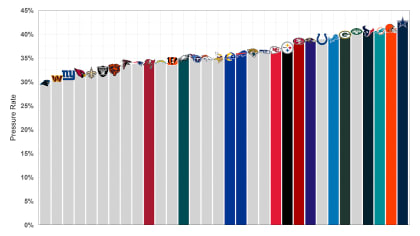NFL draft grades, NFC North: Bears lay foundation for breakthrough; Vikings aggressively roll dice
- 1-32 rankings
- AFC East
- AFC North
- AFC South
- AFC West
- NFC East
- NFC North
- NFC South
- NFC West
Why provide instant grades on the selections of prospects who have yet to take an NFL snap? Well, you’re reading this, aren’t you? Considering the makeup of every roster and the factors surrounding each pick, Gennaro Filice and Nick Shook attempt a division-by-division assessment of the 2024 NFL Draft. Keep in mind that these grades are based on draft hauls alone — picks traded for veteran players were not taken into account. Below is Gennaro’s NFC North report card.

Round 1: Caleb Williams, QB, USC (No. 1 overall) | Rome Odunze, WR, Washington (9)
Round 3: Kiran Amegadjie, OT, Yale (75)
Round 4: Tory Taylor, P, Iowa (122)
Round 5: Austin Booker, DE, Kansas (144)
At this time one year ago, Caleb Williams was the presumed No. 1 overall pick. Then we went through another football season … and Caleb Williams was the presumed No. 1 overall pick. Following a moderately spirited debate about whether Chicago should trade incumbent quarterback Justin Fields or the pick, the Bears predictably did the former and used the latter to make a no-brainer selection. So, how much credit does Chicago truly deserve here? Am I really handing out flowers for essentially having the good fortune of holding the top pick in a year when there’s a unanimous top dog? Indeed I am! Sometimes it’s better to be lucky than good. And to Bears GM Ryan Poles’ credit, he made his own luck by acquiring said pick from Carolina in a pre-draft trade last year. Furthermore, Chicago’s brain trust laid the foundation for Caleb to make a smooth transition into the NFL. Supported by a defense that’s infinitely more dependable than anything he experienced at USC, the preternaturally gifted passer is also surrounded by a cadre of weapons at running back (D’Andre Swift and Khalil Herbert), receiver (DJ Moore and Keenan Allen) and tight end (Cole Kmet and Gerald Everett). Oh, and eight picks after drafting Williams, the Bears snatched up Rome Odunze, a big-bodied playmaker who was the third wideout off the board in this class but would’ve been WR1 in many previous drafts.
So, yes, Chicago owned a sparkling grade in my book before NFL Commissioner Roger Goodell even announced the 10th pick on Thursday night. But how did the Bears fare in the rest of the draft? Well, despite limited resources, not too shabby! Kiran Amegadjie is a developmental tackle with an NFL frame, athleticism and absolute vines for arms (36 1/2 inches). Had a quad injury not ended Amegadjie’s season last October and prevented him from showing his wares throughout the pre-draft process, it’s hard to believe he’d have been available to the Bears at pick No. 75. And in addition to acquiring an intriguing edge blocker, Chicago also picked up an edge rusher with upside. Austin Booker broke out last season as a redshirt sophomore at Kansas, turning a lot of heads in the scouting community with an inspired showing versus Texas. While he didn’t knock anyone’s socks off at the NFL Scouting Combine, his raw pass-rushing ability is enticing — and his availability midway through Round 5 was a surprise. Hence Chicago trading back into the draft with a 2025 fourth-rounder to scoop him up. As for taking a punter in Round 4? Yeah, pretty bold, but Tory Taylor earned cult-hero status at Iowa for routinely bailing out the Hawkeyes’ mind-numbingly anemic offense. That said, Caleb already texted his new teammate to tell him that his services won’t be needed.

Round 1: Terrion Arnold, CB, Alabama (No. 24 overall)
Round 2: Ennis Rakestraw Jr., CB, Missouri (61)
Round 4: Giovanni Manu, OT, University of British Columbia (126) | Sione Vaki, RB, Utah (132)
Round 6: Mekhi Wingo, DT, LSU (189) | Christian Mahogany, OG, Boston College (210)
Brad Holmes and Dan Campbell have a type, and their first two picks of this draft were straight out of central casting. Anyone who has come across Terrion Arnold knows he is one of this draft’s biggest energy-givers, the kind of gregarious presence every locker room needs during the grind of a season. As NFL Network draft analyst Daniel Jeremiah said after the Lions pounced on the cornerback via trade-up, “There’s guys that like football, there’s guys that love football, and then there’s Terrion Arnold.” Yup. You saw his exhilarating, draft-night introduction to the city of Detroit, right? But the former five-star safety recruit isn’t just a fun personality — he’s a well-rounded defensive back offering just about everything you want at the position: size, physicality, ball skills, football IQ and irrational confidence. A 4.50-second 40-yard dash at the combine raised some questions about his long speed, but the play speed never appeared to be an issue at Alabama. And most notably with this particular Lions regime, Arnold plays with an undeniable edge. Just like Detroit’s second-round pick, Ennis Rakestraw Jr., who summed up his feisty game in a post-selection video chat with reporters: “I call myself the tone-setter. Our defense used to call me the firecracker of the team because, yeah, I’m a corner, but I’ll come up and set that edge and hit you like a linebacker, and I like my presence to be felt when I’m out there.” The Lions had a need at cornerback this offseason — a need that only became more pressing after the release of Cameron Sutton. And in the draft, they found great value on a pair of alpha dogs who’ll fit in perfectly with the team’s gritty culture.
Now, in the middle rounds of the draft, it seemed like Holmes was feeling himself a little bit. And who can blame him? Over his first three drafts in Detroit, the general manager uncovered a bevy of gems in Round 3 or beyond, including Amon-Ra St. Brown, Alim McNeill, Kerby Joseph, Ifeatu Melifonwu and Derrick Barnes. But Holmes was flexing in this year’s fourth round, selecting a Paul Bunyan-esque figure from the University of British Columbia (6-foot-7, 352-pound developmental tackle Giovanni Manu) and a two-way FOOTBALL PLAYER (RB/DB Sione Vaki). Both picks will probably hit and make me regret lampooning the logic. And to Holmes’ credit, he landed a couple nice value picks for trench depth in Round 6 (DT Mekhi Wingo and OG Christian Mahogany).

Round 1: Jordan Morgan, OT, Arizona (No. 25 overall)
Round 2: Edgerrin Cooper, LB, Texas A&M (45) | Javon Bullard, DB, Georgia (58)
Round 3: MarShawn Lloyd, RB, USC (88) | Ty’Ron Hopper, LB, Missouri (91)
Round 4: Evan Williams, S, Oregon (111)
Round 5: Jacob Monk, C, Duke (163) | Kitan Oladapo, S, Oregon State (169)
Round 6: Travis Glover, OT, Georgia State (202)
Round 7: Michael Pratt, QB, Tulane (245) | Kalen King, CB, Penn State (255)
Throughout the pre-draft process, one of the most common pairings in the mock milieu was Graham Barton going to Green Bay. So, naturally, when the Packers came on the clock at No. 25 and the versatile offensive lineman was still available, I mentally sent Barton to Titletown. But no! Green Bay opted for Jordan Morgan, the Arizona left tackle some project as more of an NFL guard. Where does Brian Gutekunst anticipate his new blocker to line up? In his presser after Round 1, the Packers general manager said Morgan’s a “versatile offensive lineman like we like, really athletic, we really kind of feel he could probably play four positions for us.” Yep, sounds like a Packers OL. No team develops offensive linemen better than Green Bay these days, and this approach of just drafting for the general position group and figuring out the “best five” later has proven sage with previous picks like Elgton Jenkins and Zach Tom.
In the second round, Gutey sprinkled some versatility on the back two levels of a defense that’s transitioning to new coordinator Jeff Hafley. Edgerrin Cooper, who was the first off-ball linebacker off the board, is a long, explosive, sideline-to-sideline playmaker. Lining him up next to Quay Walker gives Green Bay a tantalizingly athletic LB duo. Javon Bullard showed off his variable skill set as a plus starter in each of the past two years on Kirby Smart’s defense, which demands a lot of its defensive backs, physically and mentally. Primarily a free safety for Georgia in 2023, Bullard could line up deep, next to blockbuster free-agent addition Xavier McKinney. Or he could man the nickel, where his physicality and blitzing ability were on full display during the Bulldogs’ 2022 national title campaign.
In an underwhelming RB class, third-round pick MarShawn Lloyd had a fair amount of fans — including NFL Network draft analyst Daniel Jeremiah, who had the bursty back as his top-rated player at the position. He could provide the lightning to complement a double dose of thunder from Josh Jacobs and AJ Dillon.

Round 1: J.J. McCarthy, QB, Michigan (No. 10 overall) | Dallas Turner, OLB, Alabama (17)
Round 4: Khyree Jackson, CB, Oregon (108)
Round 6: Walter Rouse, OT, Oklahoma (177) | Will Reichard, K, Alabama (203)
Round 7: Michael Jurgens, C, Wake Forest (230) | Levi Drake Rodriguez, DT, Texas A&M-Commerce (232)
The J.J. McCarthy debate felt like the most impassioned discourse of this entire draft cycle. Essentially, there were two camps …
J.J. skeptics: He never had to carry the team and “QB WINS” is asinine.
J.J. supporters: He excelled in high-leverage situations and winning is the point of the game.
Frankly, I think both sides were right. There will be no hot take here — apologies to the culture. Anyone who watched Jim Harbaugh’s Wolverines over the last two years knows it was a run-first operation, with McCarthy throwing for a total of just 857 yards and four touchdowns over the final six games of Michigan’s national championship run this past season. On the other hand, the highly pedigreed passer flourished in big spots, routinely making the plays that needed to be made when the Wolverines needed them most. In terms of the wins? Additional context undoubtedly matters in this TEAM sport, but I also think it’s shortsighted to completely dismiss a 27-1 college record with the lone loss being a 51-45 defeat in the national semifinal.
So, where does that leave me when it comes to projecting how J.J. will fare in the NFL? In the dark. I. Don’t. Know. And that’s a scary place to be when assessing the merits of a top-10 selection. Add me to the chorus of voices saying Minnesota was the best possible landing spot for McCarthy. Kevin O’Connell has forgotten more about quarterbacking than I’ll ever know. But it’s impossible to ignore the risk associated with this premium pick. Granted, the Vikings snagged another first-rounder who was widely viewed as a steal in his draft slot — trading up for OLB Dallas Turner at No. 17 — but they sacrificed valuable draft assets in order to make that move. Which leads us to the additional rub of the Vikings’ high-stakes gamble in this year’s draft: They nuked next year’s draft currency. At the moment, Minnesota holds a grand total of three picks in the 2025 draft: one in the first round and two in the fifth.
I hope all of that provided some clarity on my thinking behind the grade above. It’s not that I know the Vikes reached on McCarthy — it’s that they pushed all their chips into the center of the table, and I have no real idea which cards they’re holding. That uncertainty makes me anxious.



